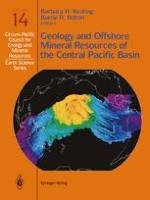1992 | OriginalPaper | Buchkapitel
Isostasy and Tectonic Origins of Pacific Seamounts
verfasst von : Jeffrey T. Freymueller, James N. Kellogg
Erschienen in: Geology and Offshore Mineral Resources of the Central Pacific Basin
Verlag: Springer New York
Enthalten in: Professional Book Archive
Aktivieren Sie unsere intelligente Suche, um passende Fachinhalte oder Patente zu finden.
Wählen Sie Textabschnitte aus um mit Künstlicher Intelligenz passenden Patente zu finden. powered by
Markieren Sie Textabschnitte, um KI-gestützt weitere passende Inhalte zu finden. powered by
Previous studies have shown that the response of the Pacific plate to oceanic island and seamount loads can be used to estimate the distribution of ridge-crest, superswell, and normal mid-plate volcanism. Similarly, estimation of the degree of Airy isostatic compensation can be used to predict the tectonic origin of an oceanic island or seamount. In this study 150 Pacific seamounts, each surveyed with at least three sea surface profiles, are classified as ridge-crest or superswell, mid-plate, or uncertain origin based on bathymetry and on-axis gravity. The results correlate well with those obtained from three-dimensional flexural and isostatic studies. Most of the analyzed seamounts rimming the Central Pacific Basin are locally isostatically compensated, i.e., ridge crest or superswell, including the Marshall Islands (10), the Mid-Pacific Mountains (5), the Line Islands (6), Tuvalu (1), and Phoenix seamounts (1). Sixteen compensated edifices were estimated on 150–170 Ma Jurassic sea floor in the Japanese (2), Magellan (3), Marcus Wake (1), and Marshall seamounts (10), but reef fossil and radiometric age determinations show no evidence of ridge crest eruptions during the Jurassic. The gravity results are therefore compatible with recent flexural studies, geochemical results, seafloor depths, age dating, and plate rotation models for other edifices in these seamount clusters that suggest eruption from a South Pacific isotopic and thermal anomaly or superswell during the Cretaceous (80–120 Ma). Recent radiometric age determinations and geochemistry indicate that four Late Cretaceous Marshall seamounts were erupted from mantle sources that are presently in the South Pacific. Our determination of 10 isostatically compensated edifices suggests that many of the Marshall seamounts may have been erupted from the South Pacific isotopic and thermal anomaly. The passage of Jurassic lithosphere over at least four superswell hot spots may also explain the apparent multiple episodes of volcanism in the Marshall Islands.
